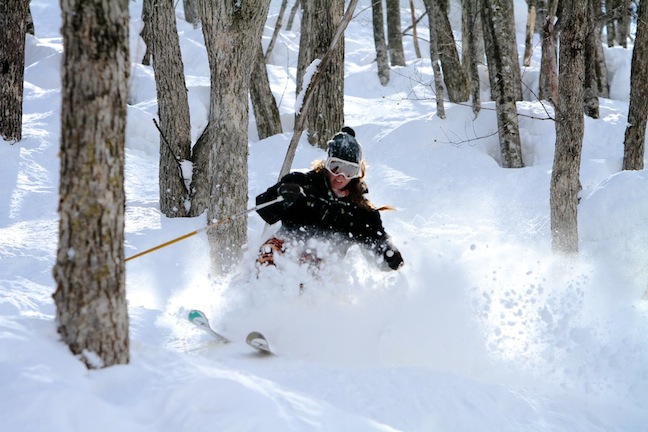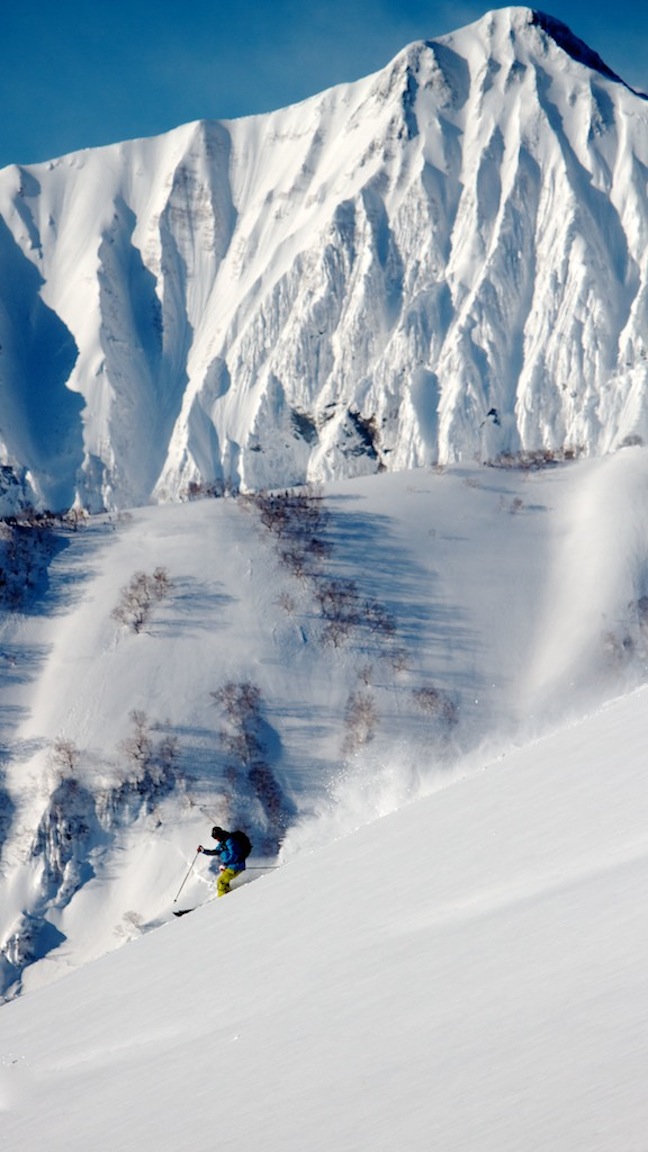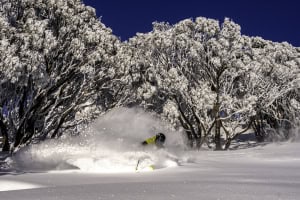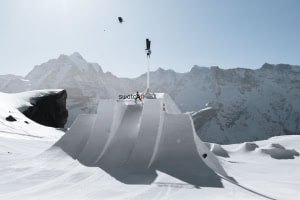SKIING & SNOWBORDING JAPAN 2012 – is it Safe? The Q&A

Hakuba powder… so very tempting. Image:: Chris Hocking
Travel Japan | Tessa Cook
Should you visit Japan?
It’s the big question for skiers and boarders in the face of the ongoing radiation crisis.
If simple answer has to be given it would be yes. All official reports, from Australia’s Department of Foreign Affairs and Trade, the Japanese Government, the Nuclear and Industrial Safety Agency and Tokyo Electric Power Company (TEPCO) say the situation is well under control and the radiation exposure risk to tourists is minimal.
But if the situation were simple the question wouldn’t linger. If you’re weighing up a trip to Japan and wondering just what is going on there, perhaps some of these, more complex questions, will go some way towards helping you make up your own mind.
What happened anyway?
When the earthquake and Tsunami struck Japan on 11 March irrevocable damage was done to the Fukushima Daiichi nuclear power plant on the central northern end of Japan’s east coast. The cooling systems were knocked out, causing meltdowns at three of the plant’s six reactors. The meltdowns released large amounts of radiation into the air, these radiation clouds travelled across Japan and beyond.
So that’s bad, how bad?
Initially, the crisis was classified as a level 5 – accident with consequences – incident on the International Nuclear and Radiological Event Scale (INES). As time has gone on and more has become known of the extent of the radiation leaks it has been reclassified as level 7 – major accident – the highest rating, shared only with the 1986 Chernobyl disaster.
The situation is still receiving extensive media coverage, what’s going on now?
The situation as it now stands can be seen in two parts. The first is the ongoing problem at the Fukushima plant. The reactors have not yet been brought to a state of cold shutdown – when temperatures are brought below 100 degrees Celsius, too cold to reheat. Until they are, the plant is still volatile and will continue to leak radiation, posing an ongoing health and environmental risk.
But work at the plant is progressing, it is the political and social situation generating so much media attention. Japan’s government is being accused severely mismanaging of the crisis and the Japanese population are frustrated and confused. The Government’s failures include:
- Withholding information from Fukushima residents in the aftermath of the disaster. A former Japanese minister says this was to prevent panic but it appears the failure to properly direct residents to places of safety may have left them exposed to large amounts of radiation in the days following the meltdown.
- Not providing adequate information on radiation. “The “official” channels are not appropriately reporting on things,” says Sean Bonner, Director of Safecast, a website set up to coordinate and track independent measuring of radiation across Japan. ” They simply aren’t releasing enough data, or specific enough data so we’re trying to fill that gap.”
- Raising the levels of radiation children can safely be exposed to on a daily basis, which means children in the vicinity of the Fukushima plant can now legally be left where they are, going about their daily lives experiencing this increased radiation exposure.
- Failing to establish a centralised food screening system to ensure contaminated produce didn’t reach market. This failure is blamed for contaminated beef and spinach reaching Japanese supermarkets.
- Not adequately supporting the Fukushima refugees and encouraging most local residents, except those within the exclusion zone around the plant, to return to their homes. Many local residents do not have confidence in the Government’s assurances that the area is safe.
The growing anti-nuclear movement is also disappointed in the Government’s seeming reluctance to commit to a move away from nuclear power for the nation.

Dream skiing – Steve Lee in Hakuba March 2011
All this talk about radiation, what does it mean?
Radiation is electromagnetic energy; infra-red heat, visible light, microwaves, radio waves and cosmic rays are all kinds of radiation surrounding us all the time, making up what is called ‘background radiation’, the radiation we are exposed to every day
This kind of radiation is considered generally harmless – with exceptions, like sunburn – however ionising radiation, the kind of radiation released by nuclear reactors, has a negative impact on living tissue, it kills bodily cells or retards cell division, it can be both immediately dangerous and create long term problems.
The danger is a matter of degree – an extremely high dose of radiation may cause an immediate response; radiation poisoning, and prolonged low level exposure may manifest itself in health problems later in life, health problems related to the dividing of cells, such as leukaemia.
The International Commission on Radiological Protection has determined the amounts of radiation people can safely be exposed to. There are different levels for the types of radioactive material and a separate level for children – as children’s cells divide more frequently, they are more at risk of complications when exposed to radiation, so too are foetuses (ie pregnant women). There are safe level guidelines for both direct exposure to radiation in the air and to consumption of food contaminated by radiation. In both cases the level isn’t zero, it’s slightly above, and even then it’s assumed a rare exposure to radiation above the safe level will not be harmful.
In the Fukushima the slow daily leaking from the damaged plant compounds the initial release of radiation. The spread and intensity of the radiation changes on a daily basis, wind and rain play a major part in determining how and where radiation will spread on any given day and where exposure will exceed daily limits.
In other words, the situation is somewhat unpredictable. Radiation above safe levels was detected in Toyko at one point, food with higher than permissible levels of contamination reached Japanese supermarkets, it is impossible to say as yet whether radiation will again reach Tokyo or contaminated food will again appear on the market.
That’s a terrible situation for the Japanese people, what impact does it all have on the snow resorts?
By all accounts, not much. Radiation does not seem to have spread to the major snow resort areas. While there are some small resorts close to Fukushima the larger commercial resorts in the Hokkaido and Honshu regions are all many hundreds of kilometres away from the plant. Safecast’s radiation mapping project is not showing heightened radiation levels in the areas and neither are any other organisations detecting abnormalities.
“We receive regular updates from JNTO (Japan National Toursim Organisation) about radiation levels and government travel advisories,” says Quentin Nolan, Director of the Australian based Liquid Snow Tours, Japan travel specialists. “The information is produced by independent organisations and UN officials testing radiation levels through the country. For this reason we feel this is the best source of information and we generally refer customers to it when they have questions or concerns.”
In the aftermath of the disaster Tokyo experienced several days of heightened radiation levels, specifically higher than allowable levels iodine in the drinking water, but the city has been clear for several months.
Food contamination scares seem to have been contained. “The main problem was crops like spinach that were growing outdoors in March,” says Martin Frid from the Consumers Union of Japan. “No such food is sold today. And food grown during the summer has not been found to have any high levels of radioactivity.
“Also, there was a problem with beef from cattle that had been fed hay and straw that had been exposed in March. As far as we know, such beef is not on the market now.”
So if it all seems safe, why all the bru-ha-ha?
Opinions regarding the extent of the disaster are still very divided. Some experts, notably Australia’s Dr Helen Caldicott, believe the situation is far worse than the Japanese government is admitting and that north west Japan should be evaluated. As an avid anti-nuclear campaigned Dr Caldicott’s voice is joined by many others in the anti-nuclear lobby. Then there are those, especially in the pro-nuclear camp, such as British political analyst Malcolm Grimston who believes the situation is well under control.
More temperate experts believe the situation won’t be fully understood, either way, for many months. Regardless, these outspoken voices are just one part of a chorus that includes the dispossessed residents of Fukushima, the anti-nuclear Japanese and others both within the country and outside it dissatisfied with how the situation is being handled. These are the ongoing concerns keeping the Fukushima disaster so much in the media.
In the end…
Only you can decide whether you’ll visit Japan this winter and if you do, whether you’ll pack a Geiger counter and a holiday-long supply of space food sticks. One thing’s for sure, if you do go, you’ll score some good deals and more space on the slopes…
If you want to know more:
http://www.dfat.gov.au/ – Australia’s Department of Foreign Affairs and Trade is the first stop for anyone looking for information on overseas travel
http://www.jnto.org.au/ – Japan Tourism’s Australia website features Earthquake updates and information on radiation
http://www.nishoren.org/ – The Consumers’ Union of Japan is monitoring the food situation
http://maps.safecast.org/ – Safecast is an independent website monitoring and tracking radiation readings across Japan. Their maps give a good picture of radiation spread and intensity
Hakuba forecasts,
snow reports and
live snow cams.
Niseko forecasts,
snow reports and
live snow cams.






